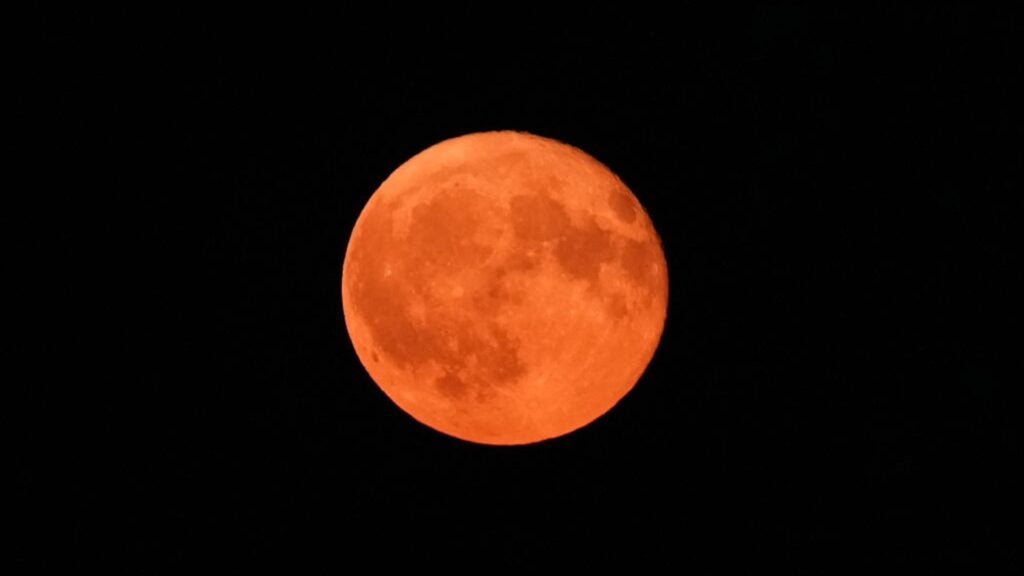The first lunar eclipse of 2025, set to occur in the early hours of March 14, presents an extraordinary viewing opportunity for astronomy enthusiasts across North America. This celestial event, known as a total lunar eclipse, will cause the moon to glide into Earth’s shadow, resulting in a striking blood moon that glows with a haunting tangerine hue. Such spectacles have not graced the skies since November 2022, and won’t reappear in the U.S. until 2026. The good news is that this phenomenon is easily observable, even from urban areas laden with light pollution.
What Happens During a Total Lunar Eclipse?
During a total lunar eclipse, Earth’s shadow progressively covers the full moon, creating an event that can last several hours. The eclipse begins with a subtle phase when the moon moves into Earth’s outer shadow, occurring just before midnight ET on March 13. The partial eclipse, where a noticeable segment of the moon seems to be missing, starts around 1 A.M. ET on March 14, culminating in totality by approximately 2:30 A.M. ET. During totality, the moon achieves its captivating blood-red glow for around an hour, before transitioning back to a partial state and eventually returning to normal.
Why is the Moon Red During a Lunar Eclipse?
The captivating red hue of a blood moon is the result of light refraction. As sunlight passes through Earth’s atmosphere, shorter wavelengths, particularly blue light, scatter, while longer wavelengths—red and orange—pass through. This filtered light reaches the moon, casting a captivating red glow. In contrast to a solar eclipse, which lasts only a few minutes, total lunar eclipses like this one offer a prolonged display, lasting a full hour during totality. According to Space.com, such events can typically be observed from specific locations about every 2.5 years, but North Americans have a unique advantage as they get to experience the next total eclipse on March 3, 2026.
Best Practices for Viewing the Lunar Eclipse
To maximize your eclipse experience, find a clear view of the southern sky, as the moon will be moving across this area during the event. Look out for Mars and Jupiter, located near the western horizon leading up to the blood moon. If overcast skies are a concern, don’t be discouraged; even partial cloud cover can enhance the eeriness of the blood moon. Plan to head outside around 1:30 A.M. ET to watch the moon begin to exit Earth’s shadow, with totality commencing at 2:30 A.M. ET.
Unique Locations to Experience the Blood Moon
For those interested in turning their eclipse-watching into a longer getaway, several accommodations in the U.S. offer prime viewing options. Whether it’s enjoying the spectacle from a cozy cabin with a hot tub or from the comfort of your bed, there are numerous choices to suit every preference.
Northeast Options
The Mirror Lake Inn in Lake Placid, NY, provides a picturesque backdrop with all rooms facing south towards the lake, ideal for watching the eclipse. Alternatively, the Skyline Serenity Cabin in Pennsylvania features a hot tub and panoramic views, nestled in the scenic Allegheny Mountains.
Midwest Spots
If you’re located in the Midwest, the Keweenaw Mountain Lodge in Michigan offers a certified dark-sky park for optimal stargazing. For a unique experience, consider the Lookout Loft Treehouse in South Dakota, which provides an elevated perspective perfect for moon-gazing.
Planning Ahead for a Magical Night
The upcoming total lunar eclipse is an event not to be missed, especially for those who enjoy celestial phenomena. To prepare for this unique lunar experience, plan ahead to secure viewing accommodations and check the weather forecast. To enhance your experience, you may also want to research local stargazing events or eclipse-related activities around your chosen location.
